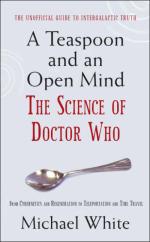A Teaspoon and an Open Mind
The Science of Doctor Who
|
|
Allen Lane A Teaspoon and an Open Mind The Science of Doctor Who |
| Author | Michael White |  |
| ISBN | 0 713 99905 5 | |
| Publisher | Allen Lane | |
| Published | 2005 |
| Summary: Applying the latest scientific thinking to the concepts of Doctor Who |
A Review by Finn Clark 11/5/06
This book is fascinating. Admittedly it's a hurriedly written cash-in with Doctor Who content that's at times risible, but it deserves praise for being more intellectually stimulating than any previous such example. Peter Haining, eat your heart out. (Before anyone mentions The Unfolding Text, that was an academic treatise rather than an attempted cash-in. Its authors were probably astonished that anyone outside the university sphere bought it.) This is a pop science book with a poor fig-leaf of occasional Doctor Who references, but once you've accepted that then it's a very good read.
As a Doctor Who book it's laughable. I'm prepared to believe that Michael White remembers the show fondly and there's evidence that he's watched a few seventies stories, such as The Time Monster, The Invisible Enemy and The Creature from the Pit, the latter because of the book's title. It's a quote: "Well, to be fair I did have a couple of gadgets he probably didn't, like a teaspoon and an open mind." However the author thinks the third Doctor was played by John Pertwee and that the episode of Doctor Who broadcast on 23 November 1963 was simply called "Doctor Who - Episode One". Clearly no fans helped with the proofreading of this book.
However I didn't mind that. It's not trying to be a Doctor Who book. Sometimes its unfamiliarity with Who even leads it to unintentionally entertaining choices, such as its examples of classic Doctor Who robots on p112. "The Doctor has faced some pretty unpleasant robotic enemies, including BioMechanoid, a cyberdragon from the planet Svartos, the Yeti, and of course the very unpleasant Robots of Death." In general each chapter has an attention-grabbing title ("Bring on the Daleks: What Would Aliens Really Look Like?") and a token page or two of Whoish chit-chat, after which he gets down to the science.
Most importantly it's good science! It's also impressively wide-ranging. Its chapters cover weird high-level physics (relativity, quantum mechanics, etc.), astrophysics (the criteria for life on other planets) and the history of life and civilisation on Earth. Some of its discussion is practically forteana. Chapters five and six in particular talk about seriously weird shit, digging up some fascinating experimental results within the context of repeatable scientific investigation. Their titles are "Superganglion: Are Telepathy and Telekinesis Possible?" and "Supercivilizations: Do Superraces Exist?". The latter in particular covers some surprising ground, investigating Atlantis in detail and also considering Von Daniken, Plato and the Baghdad battery. Many fans will be familiar with some of this book's material, perhaps having studied relativity or quantum mechanics at university for instance, but I'd be astonished if anyone already knew it all. The breadth of its scope is fascinating in itself.
Michael White is also good at showing science not as an ossified body of wisdom but as a dynamic ongoing process. The "By The Same Author" page shows him to be almost more of a historian than a scientist, although admittedly many of his biographies are of scientists (Newton, Galileo, Stephen Hawking) or creative figures who were scientists too (Isaac Asimov, Leonardo da Vinci). He's strong on showing the historical development of science, showing how discoveries and theories changed people's thinking. It's almost a story. In particular he gives lots of dates, coming right up to the present day (2005) with some up-to-date scientific results.
There are many points a Doctor Who fan would have addressed differently, but that's not always a bad thing. I like his quotes and literary examples, which are less likely to be TARDIS-bound than to be something like Heinlein, H.G. Wells or Sliding Doors. However on many occasions he's obviously unaware of the Whoniverse implications. When talking about the difference between carbon and silicon-based life forms for instance, he's unaware that Doctor Who has addressed this and specifically described the latter as unusual. City of Death is affected by p53, while p60 explains why so many aliens (in particular the Silurians) are just men in suits. Furthermore p35 is crying out for an Adric reference, although in fairness I did get a kick from the mention of his anagrammed-namesake Paul Dirac on p69. I also hadn't realised how many of Doctor Who's crystalline entities have K-names (p166).
Michael White occasionally skims over points of scientific contention because he doesn't want to get bogged down in tangents. However his basic perspective is refreshing. Unlike most fans, he's not starting from the principle of "accepting Doctor Who as literally true, what do this mean for science and what assumptions can we make?". Instead he's bringing the latest scientific thinking to bear on the fictional principles underlying Doctor Who. Admittedly he's here to say "what if?" rather than just dismiss things as impossible, but dimensional transcendentalism for instance gets short shrift from him. That's in the epilogue which for once isn't just a general science chapter but more specifically addressing Doctor Who's peculiarities.
I'd love to see how this book compares with the upcoming The Science of Doctor Who, as plugged extensively in the April edition of the BBC's science and technology magazine Focus. Its author (and Focus's editor) Paul Parsons is apparently a fan, so I suspect it'll be taking a different angle on what should theoretically be the same issues. Nevertheless this book is an interesting and worthwhile read. If nothing else, I was happy to see for once the correct scientific use of the word "organic". Sorry. Personal hobby horse.